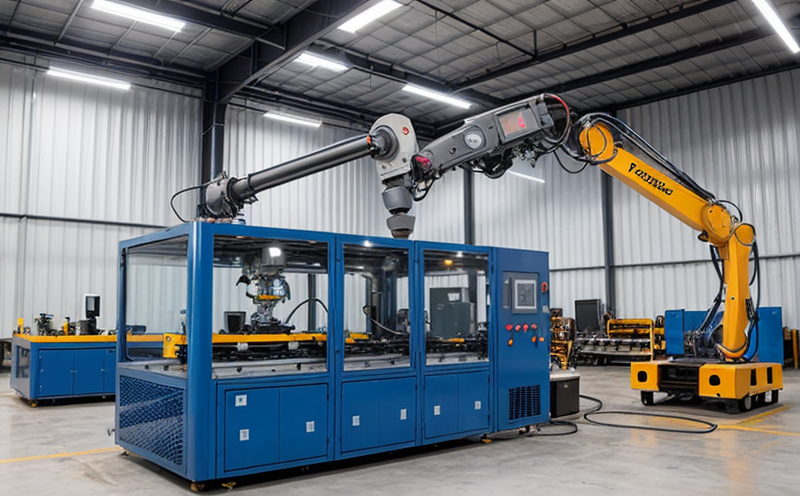ASTM F3000 Human Robot Interaction Safety Testing
The ASTM F3000 standard provides a framework for ensuring the safety of human-robot interactions in industrial environments. This service focuses on testing systems that incorporate advanced robotics and automation, which are increasingly used in manufacturing processes to enhance productivity and efficiency. By adhering to this standard, manufacturers can ensure that their robotic systems do not pose an undue risk to workers.
The ASTM F3000 test protocol is designed to evaluate the safety of robots interacting with humans by measuring factors such as force, speed, and proximity detection capabilities. It is critical for industries like automotive manufacturing, electronics production, and logistics where robotics play a significant role in daily operations. Compliance with this standard not only protects workers but also helps companies meet regulatory requirements and maintain their reputation.
The testing process involves simulating various scenarios that could occur during human-robot interaction to assess the robot's response. This includes determining how quickly a robot can stop if it detects an obstacle, whether it can differentiate between a human and another object, and its overall behavior when encountering unexpected situations. These tests are conducted using specialized equipment capable of accurately measuring forces exerted by robots on humans.
The ASTM F3000 standard has been instrumental in fostering safer working environments within industrial settings. As robotics technology continues to advance, it becomes essential for organizations to adopt standards that promote both innovation and safety. By offering ASTM F3000 Human Robot Interaction Safety Testing services, we contribute to creating a more secure environment where humans and machines can coexist harmoniously.
Our expertise lies in understanding the intricacies of industrial robotics systems and tailoring our testing protocols accordingly. We employ state-of-the-art instrumentation that allows us to conduct thorough evaluations under controlled conditions. Our team of certified professionals ensures adherence to international standards, providing clients with reliable and accurate results.
To better understand how this service can benefit your organization, let's delve into its competitive advantages:
- Ensures compliance with industry-leading safety protocols
- Promotes continuous improvement in robotic system design
- Reduces potential risks associated with human-robot interactions
- Enhances overall industrial safety standards
- Supports regulatory compliance and reduces liability concerns
In addition to these benefits, our service also contributes significantly towards enhancing market impact. By demonstrating commitment to worker safety and technological advancement through rigorous testing, companies can gain a competitive edge in their respective markets.
Customer Impact and Satisfaction
The implementation of ASTM F3000 Human Robot Interaction Safety Testing brings about numerous advantages for our customers. Firstly, it ensures that the robotic systems used in their manufacturing processes are safe for human workers to operate alongside. This not only enhances productivity by allowing continuous operation but also reduces the risk of accidents or injuries.
Secondly, compliance with this standard can help businesses avoid costly lawsuits and penalties related to workplace safety violations. By proactively addressing potential hazards through thorough testing, companies demonstrate their dedication to maintaining high standards of care for employees.
Thirdly, adopting ASTM F3000 practices reflects positively on a company’s corporate social responsibility (CSR) initiatives. It signals that the organization prioritizes both employee welfare and sustainable development goals, which can be appealing factors for investors and stakeholders alike.
Moreover, adhering to these stringent safety measures helps establish trust among employees who feel protected while performing their tasks effectively. This fosters a positive work culture where innovation meets responsibility, leading to increased job satisfaction and reduced turnover rates.
Our customers appreciate the comprehensive nature of our testing services which go beyond mere certification checks. We offer in-depth analysis reports that highlight areas for improvement within existing robotic systems. These insights enable manufacturers to refine their products continually, ensuring they stay ahead of emerging trends and technological advancements.
Competitive Advantage and Market Impact
- Enhanced Reputation: By offering ASTM F3000 Human Robot Interaction Safety Testing, we help our clients build a strong reputation for being leaders in workplace safety.
- Innovation Leadership: Our services encourage the development of safer and more efficient robotic systems, positioning companies as pioneers in industrial automation.
- Promotes Regulatory Compliance: Ensuring adherence to international standards such as ASTM F3000 can reduce legal risks associated with non-compliance.
- Sustained Competitive Edge: Demonstrating a commitment to worker safety through rigorous testing enhances customer trust and loyalty, thereby strengthening market position.
The impact of these advantages extends far beyond individual businesses; it contributes significantly towards shaping the future landscape of industrial robotics. As more organizations adopt similar practices, industries as a whole benefit from increased innovation, reduced accidents, and improved overall safety standards.
Use Cases and Application Examples
- Automotive Manufacturing: In automotive plants where robots perform critical tasks like welding and painting, ensuring safe human-robot interactions is paramount. Testing according to ASTM F3000 helps manufacturers comply with local regulations while enhancing worker safety.
- Electronics Production: For companies involved in high-tech electronics assembly, precision and speed are crucial. Proper testing ensures that robots can operate efficiently without causing harm to operators.
- Logistics and Warehousing: In warehouse environments where autonomous guided vehicles (AGVs) navigate crowded spaces, ASTM F3000 helps prevent collisions between humans and machinery.
These examples illustrate just a few of the many industries that can benefit from our ASTM F3000 Human Robot Interaction Safety Testing service. Each application highlights unique challenges and opportunities for improving safety and operational efficiency through rigorous testing.
In conclusion, by embracing ASTM F3000 standards, businesses demonstrate their commitment to creating safer workplaces while staying at the forefront of technological progress. This dedication not only protects employees but also contributes positively towards shaping a future where humans and machines coexist safely and effectively.





